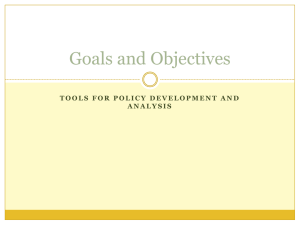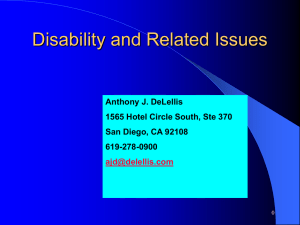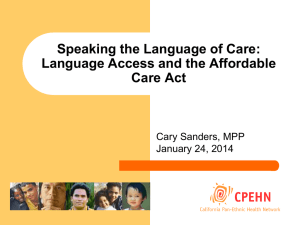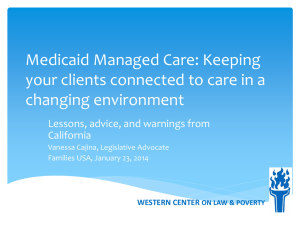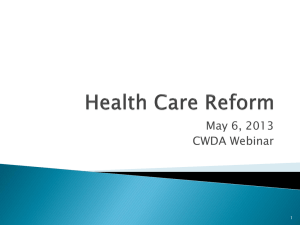Power Point Presentation
advertisement
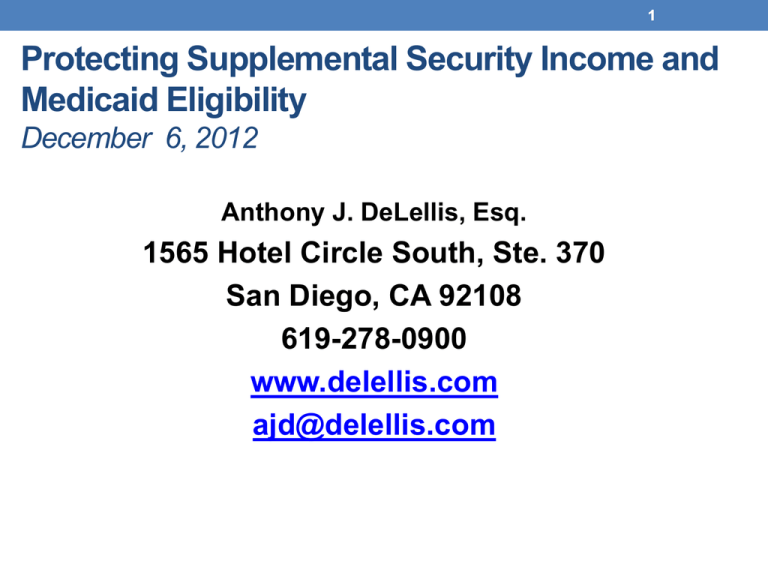
1 Protecting Supplemental Security Income and Medicaid Eligibility December 6, 2012 Anthony J. DeLellis, Esq. 1565 Hotel Circle South, Ste. 370 San Diego, CA 92108 619-278-0900 www.delellis.com ajd@delellis.com 2 SOCIAL SECURITY DISABILITY Disability: The inability to engage in any substantial gainful activity by reason of any medically determinable physical or mental impairment which can be expected to result in death or which has lasted or can be expected to last for a continuous period of not less than 12 months. 42 U.S.C. 423(d)(1)(A) 3 Five Step Sequential Evaluation 1. The Claimant is not engaging in “substantial gainful 2. 3. 4. 5. activity” (SGA); and The Claimant has a “Severe” impairment; and The impairment meets or “equals” one of the impairments in the regulations known as the “Listing of Impairments”; -orConsidering the Claimant’s “residual functional capacity” (RFC), the Claimant is unable to do “past relevant work”; -andOther work with the claimant’s RFC, considering age, education and work experience, does not exist in the national economy in significant numbers. 4 Step 1: Substantial Gainful Activity • Work must be both “substantial” and “gainful”. • Gainful work for 2009 was $980 per month and $1000 per month for 2010 and 2011 and $1010 for 2012. ($1,690 if blind) Self Employed work is “gainful” if it is the kind of work usually done for profit, regardless if there is a profit or loss. • Substantial work means that the claimant is able to do the ordinary tasks of the job without special assistance or the claimant is of “little or no use” to the employer. This is referred to as a “sheltered work environment”. 5 Step 2: Severe Impairment • This step is designed to weed out frivolous claims involving no medically determinable impairment or only a “slight” impairment that results in a “minor” limitation on the ability to work. • Medically determinable impairments are divided into two categories: 1. Slight impairments that are referred to as “non-severe” impairments and 2. All other impairments that are, therefore, “severe.” 6 1. The regulations require that the impairment must be continuously “severe.” This precludes conditions that wax and wane or have periods of remission followed by active periods. However if the remission is for short periods followed by active periods which preclude SGA then the duration requirement is met. 2. A claimant is not permitted to tack together unrelated severe impairments to get to the 12 month requirement. 42 U.S.C. 423(d)(2)(a) 7 Step 3: Listings of Impairments • A Claimant will be found disabled if the medical signs, findings and symptoms meet or “medically equal” one of the disabilities found in the Listing of Impairments. • If meet or equals a listing, the Claimant will be found disabled even if he/she is able to do past work or hypothetically retains ability to do substantial gainful activity. 8 Step 4: Past Relevant Work 1. The Claimant has the burden of proving that he/she cannot perform any of the work he/she performed in the past 15 years. 2. If can perform PRW, not disabled. The case may be a winner at Step 5 but can’t get there if lose at Step 4. 3. The Past Work must have been performed at Substantial Gainful Activity levels. 9 4. Must have been performed long enough to learn that work. Each job is defined in the Dictionary of Occupational Titles and is given a specific SVP number from 1 to 8. Unskilled jobs have an SVP of 1-2 and take 30 days to learn. Semi Skilled jobs have an SVP of 3-4 and take 30 to 90 days to learn. Skilled jobs have an SVP of 5-8 and require 6 months to learn. 5. In evaluating a claim, look through the claimant’s work history and determine which is the easiest job that they performed. The burden is to show what medically determinable impairments preclude him or her from performing this work now. 10 Step 5: Other Work Does Not Exist If can’t do PRW, the issue at Step 5 is whether there are jobs that exist in significant numbers that the Claimant has the Residual Functional Capacity to perform. Medical Vocational Guidelines, known as the GRIDS are used at this step. The GRIDS take into consideration the claimant’s age, education and past work experience. Using this information, a finding of disabled or not disabled is directed. Often a Claimant’s impairments do not fall into nice and neat categories. If so, the ALJ needs to have a vocational expert who can testify how the impairments erode the occupational base of jobs which exist. For example, a claimant has a major depressive disorder, bilateral carpel tunnel and a 10lb lifting limit. The Grids don’t help but there are no jobs that exist in “significant numbers” with this combination of impairments. 11 Social Security Disability Insurance • Medical Disability. Use the 5 step sequential evaluation. • Must have worked for 20 Quarters out of the last 40 • • • • Quarters. Must earn $1,120 to get credit for a quarter. Earnings Requirement. Must have worked a minimum numbers of 40 Quarters throughout life. This rule is relaxed for younger claimants. Retroactive benefits extend up to 1 year before the application was filed. Six (6) month waiting period. (Unless disability on the 1st day of the month) Medicare Health Insurance. SSDI waiting period plus 24. 12 Additional Requirements for Supplemental Security Income Claimants • Medical Requirements. Use the 5 step sequential evaluation. • Financial Requirements. Cannot have more than $2,000 in • • • • assets. $3,000 if married. Excludes a vehicle used to transport to and from medical visits, household furniture and furnishings and the principal residence. Deeming. Considering a spouse’s income. Must be a citizen. If non citizen, must be here legally since prior to August of 1996 or here as a refugee or has political asylum. Retroactive benefits from the date of filing Application Medi-Cal Health Insurance 13 Medi-Cal Program Overview • Medi-Cal is the California program for Medicaid and provides health coverage to low income people that meet minimum asset levels and are disabled. • Medi-Cal will pay for “medically necessary” health care including physician visits, X-Ray and lab tests, nursinghome care, home health care, prosthetics, medical equipment and prescription drugs not covered by Medicare Part D. • Medi-Cal will pay for Medicare Part A and B deductibles and copayments. • Medi-Cal will pay for the monthly Medicare Part B premium. 14 Medi-Cal Qualifications • Supplemental Security Income (SSI). If you qualify for SSI you automatically qualify for full Medi-Cal coverage. • Your monthly income must not exceed $830 for one or $1,407 for a couple. • Aged and Disabled Federal Poverty Level Program • If 65 or disabled but not eligible for SSI can still qualify if income is less than the federal poverty level of $1,161 for one or $1,571 for a couple. Must still meet SSI resource limits. • Medi-Cal with a Share of Costs • If your income is higher than the Federal Poverty Level but you meet the asset level requirements, eligible for Medical with an SOC. Take your income and subtract $600 ($934/couple). This is the monthly deductible. 15 Medi-Cal Qualifications (Cont.) • 250% California Working Disabled Program • You must meet the requirements of the Social Security Disability program for a “medical disability”. • Your income is less than 250% of the federal poverty level which is $2,328/$3153 per month, and • You meet the SSI Resource Limits May qualify to purchase Medi-Cal by paying a monthly premium based on a sliding scale. For more information or to apply on line: www.sdcounty.ca.gov 16 Resolving Claims when your client is receiving SSI Benefits or Medi-Cal Benefits. • Utilizing the SPEND DOWN option When an SSI/Medi-Cal recipient receives a lump sum settlement they must either establish a special needs trust or do a spend down of the funds. The failure to do so will terminate benefits for your client and/or a disabled child. If the settlement is relatively small or there is a need for the purchase of a high ticket item, the spend down option may be most favorable. The funds must be spent on exempt resources and the items purchased must be used for the benefit of the beneficiary. The following is a list of exempt expenditures: Purchase a home, pay off mortgage, pay rent for that calendar month Modify a home to accommodate an individual’s disability 17 Purchase an interest in child’s home if parent intends to live there Purchase home furnishings or appliances Home repair and deferred maintenance including landscaping Medical expenses/bills not covered by Medi-Cal Dental Expenses, eye glasses, physical therapy, support services not covered by any benefit program Education expenses including a computer, software, and books Entertainment/recreation expenses such as books, movies, concerts and tickets Vacation travel including airline tickets, bus and train 18 Attorney fees for estate planning and Medi-Cal planning Pay off unsecured debts such as credit cards and loans with supporting documentation Pre-pay burial arrangements Personal hygiene (haircuts, manicures) Purchase an automobile, pay for registration and insurance Purchase clothing Practice Tips: • Provide the settlement funds at the beginning of the calendar month to give your client time to spend down • Advise the client they must receive Fair Market Value for each transaction. If not, there will be a period of ineligibility from 1 month to 36 months. 19 • Advise the client to maintain copies of all receipts • If a home was purchased they must have their name on the title • If a vehicle was purchased they must have their name on the certificate • If auto insurance was purchased, they must be the loss payee • The spend down must be reported by the 10th day of the following month. They will have to repay Social Security for their SSI payment during the month(s) in which they had excess resources. 20 • Utilizing the SPECIAL NEEDS TRUST option The SNT is an irrevocable trust that holds title to the property or settlement for the benefit of the person who is disabled. The SNT can be used to provide for the needs of the disabled person to supplement SSI and Medi-Cal benefits. The SNT can hold cash, personal property and real estate and be the beneficiary of a life insurance policy. The general rule is that a SNT pays for items other than food and shelter. These items could be paid for but the purchase of “in kind support and maintenance” and will create a reduction up to $252.66 per month. 21 Items that can be paid for by the SNT include: • Furniture and furnishings • Clothing • Entertainment • Education including books, tuition, tutors and supplies • Computers and printers • Cable T.V. • Internet Services • Household supplies and cleaning products • Health care expenses not covered by Medi-Cal • Medical supplies and equipment not covered by Medi-Cal • Life and Health insurance premiums 22 • Phone and mobile phones • Vision and eyeglasses • Dental • Medical procedures even if not medically necessary • Travel expenses • Vacations • Exercise and physical therapy equipment • Tools used for home repairs • Companionship

